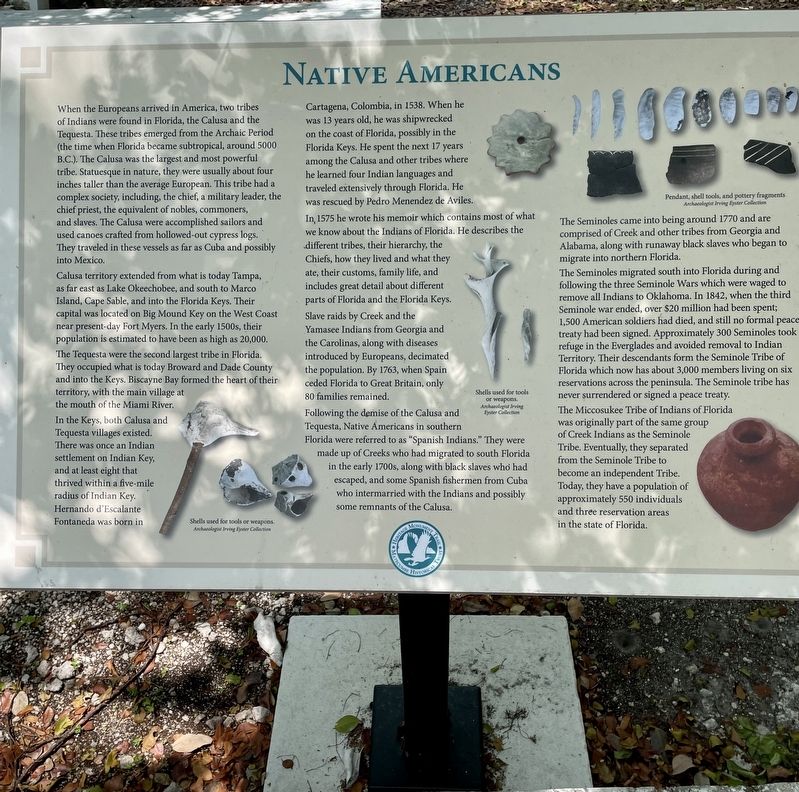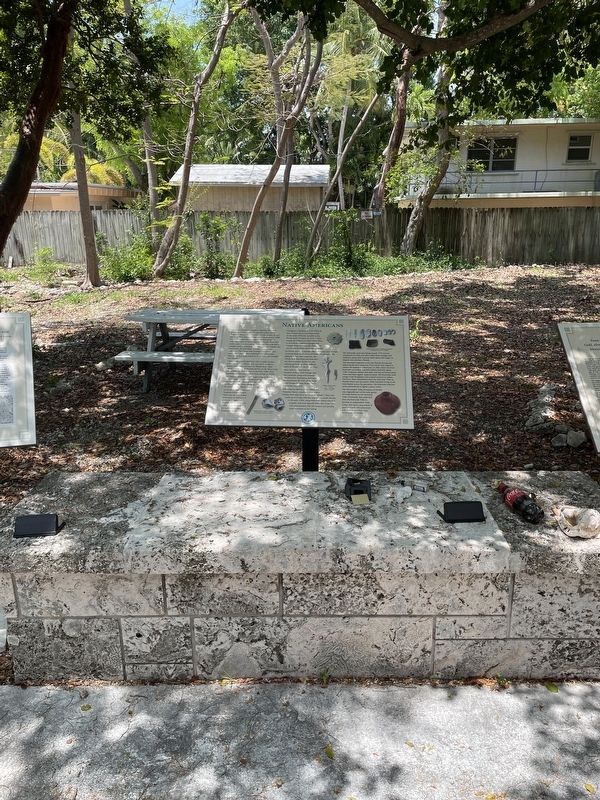Islamorada in Monroe County, Florida — The American South (South Atlantic)
Native Americans
Heritage Monument Trail, Matacumbe Historical Trust
When the Europeans arrived in America, two tribes of Indians were found in Florida, the Calusa and the Tequesta. These tribes emerged from the Archaic Period (the time when Florida became subtropical, around 5000 B.C.). The Calusa was the largest and most powerful tribe. Statuesque in nature, they were usually about four inches taller than the average European. This tribe had a complex society, including, the chief, a military leader, the chief priest, the equivalent of nobles, commoners, and slaves. The Calusa were accomplished sailors and used canoes crafted from hollowed-out cypress logs. They traveled in these vessels as far as Cuba and possibly into Mexico.
Calusa territory extended from what is today Tampa, as far east as Lake Okeechobee, and south to Marco Island, Cape Sable, and into the Florida Keys. Their capital was located on Big Mound Key on the West Coast near present-day Fort Myers. In the early 1500s, their population is estimated to have been as high as 20,000.
The Tequesta were the second largest tribe in Florida. They occupied what is today Broward and Dade County and into the Keys. Biscayne Bay formed the heart of their territory, with the main village at the mouth of the Miami River.
In the Keys, both Calusa and Tequesta villages existed. There was once an Indian settlement on Indian Key, and at least eight that thrived within a five-mile radius of Indian Key. Hernando d'Escalante Fontaneda was born in Cartagena, Columbia, in 1538. When he was 13 years old, he was shipwrecked on the coast of Florida, possibly in the Florida Keys. He spent the next 17 years among the Calusa and other tribes where he learned four Indian languages and traveled extensively through Florida. He was rescued by Pedro Menendez de Aviles.
In, 1575 he wrote his memoir which contains most of what we know about the Indians of Florida. He describes the different tribes, their hierarchy, the Chiefs, how they lived and what they ate, their customs, family life, and includes great detail about different parts of Florida and the Florida Keys.
Slave raids by Creek and the Yamasee Indians from Georgia and the Carolinas, along with diseases introduced by Europeans, decimated the population. By 1763, when Spain ceded Florida to Great Britain, only 80 families remained.
Following the demise of the Calusa and Tequesta, Native Americans in southern Florida were referred to as "Spanish Indians." They were made up of Creeks who had migrated to south Florida in the early 1700s, along with black slaves who had escaped, and some Spanish fishermen from Cuba who intermarried with the Indians and possibly some remnants of the Calusa.
The Seminoles came into being around 1770 and are comprised of Creek and other tribes from Georgia and Alabama, along with runaway black slaves who began to migrate into northern Florida.
The Seminoles migrated south into Florida during and following the three Seminole Wars which were waged to remove all Indians to Oklahoma. In 1842, when the third Seminole war ended, over $20 million had been spent; 1,500 American soldiers had died, and still no formal peace treaty had been signed. Approximately 300 Seminoles took refuge in the Everglades and avoided removal to Indian Territory. Their descendants form the Seminole Tribe of Florida which now has about 3,000 members living on six reservations across the peninsula. The Seminole tribe has never surrendered or signed a peace treaty.
The Miccosukee Tribe of Indians of Florida was originally part of the same group of Creek Indians as the Seminole Tribe. Eventually, they separated from the Seminole Tribe to become an independent Tribe. Today, they have a population of approximately 550 individuals and three reservation areas in the state of Florida.
(Captions)
Shells used for tools or weapons.
Archaeologist Irving Byster Collection
Shells used for tools or weapons. Archaeologist Irving Eyster Collection
Pendant, shell tools, and pottery fragments Archaeologist Irving Eyster Collection
Erected by Heritage Monument Trail, Matacumbe Historical Trust.
Topics. This historical marker is listed in these topic lists: Anthropology & Archaeology • Exploration • Native Americans • Wars, US Indian.
Location. 24° 55.575′ N, 80° 37.583′ W. Marker is in Islamorada, Florida, in Monroe County. Marker can be reached from Overseas Highway (U.S. 1) north of North Ocean Lane (County Route 931), on the right when traveling south. Touch for map. Marker is at or near this postal address: 82616 Overseas Highway, Islamorada FL 33036, United States of America. Touch for directions.
Other nearby markers. At least 8 other markers are within walking distance of this marker. The Spanish Treasure Fleets (here, next to this marker); The Early Settlers of Upper Matecumbe Key (here, next to this marker); Geological History of the Florida Keys (here, next to this marker); The Florida Keys Memorial (here, next to this marker); The Railway That Went To Sea (here, next to this marker); The Storm that Still Howls (a few steps from this marker); Site of Islamorada Railway Station (approx. ¼ mile away); The 1935 Hurricane (approx. 0.9 miles away). Touch for a list and map of all markers in Islamorada.
Also see . . .
1. Tequesta, Muspa and Calusa: South Florida’s Indigenous Residents. (Submitted on May 6, 2023, by Brandon D Cross of Flagler Beach, Florida.)
2. Heritage Monument Trail, Matacumbe Historical Trust. (Submitted on May 6, 2023, by Brandon D Cross of Flagler Beach, Florida.)
Credits. This page was last revised on May 8, 2023. It was originally submitted on May 6, 2023, by Brandon D Cross of Flagler Beach, Florida. This page has been viewed 53 times since then and 7 times this year. Photos: 1, 2. submitted on May 6, 2023, by Brandon D Cross of Flagler Beach, Florida. • Bernard Fisher was the editor who published this page.

